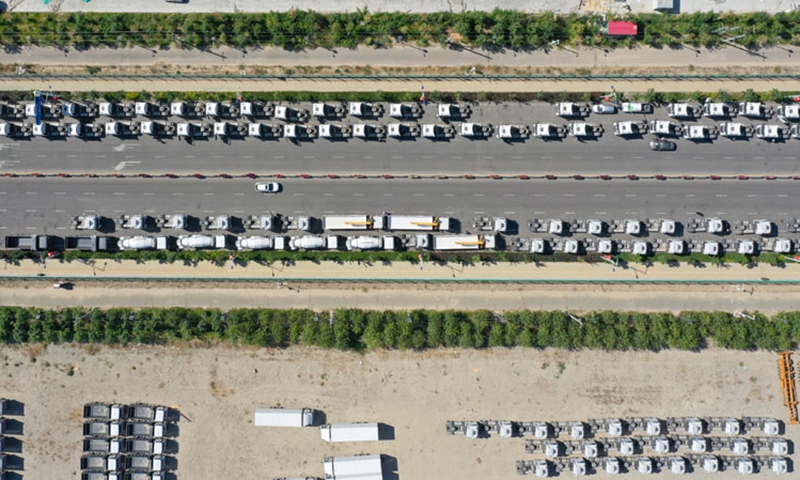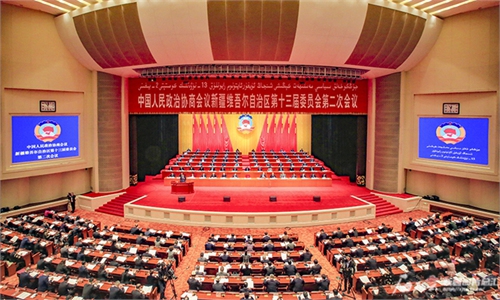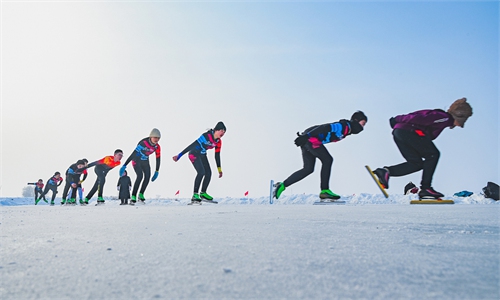Xinjiang sees robust growth in trade, GDP, laying bare failure of Western crackdown

This aerial photo taken on July 26, 2023 shows domestically-made vehicles at the Horgos comprehensive bonded area in northwest China's Xinjiang Uygur Autonomous Region. More and more domestically-made automobiles have been exported through the Horgos Port, one of China's closest ports to Central Asia and Europe by land transport, to countries along the Belt and Road, including Kazakhstan, Uzbekistan and Russia. Photo: Xinhua
Northwest China's Xinjiang Uygur Autonomous Region took the lead in China's exports to the five Central Asian countries in 2023, with a year-on-year growth of 23.2 percent, the Xinjiang Daily newspaper reported on Monday, adding to a slew of indicators that pointed to the region's robust economic growth in 2023, which was also among the fastest-growing local economies in the country.
With its critical role in China's westward opening-up and the Belt and Road Initiative (BRI) as well as social stability and focus on development, Xinjiang is expected to see impressive growth in 2024 and beyond, experts said. Such a trend also highlighted the failure and collapse of the West's ill attempt to crack down on and contain the region's development, the experts noted.
In 2023, Xinjiang's exports to the five Central Asian countries - Kazakhstan, Kyrgyzstan, Tajikistan, Turkmenistan and Uzbekistan - jumped by 23.2 percent year-on-year to 246.57 billion yuan ($34.25 billion), the largest in the country, according to Xinjiang Daily, citing data from Urumqi Customs.
Central Asia remained Xinjiang's largest trade market, with total imports and exports surging 50 percent year-on-year in 2023 and accounting for 79.4 percent of Xinjiang's total imports and exports, thanks to Xinjiang's critical role as a frontier in China's westward opening-up and a crucial area for the BRI.
This is just the latest set of data pointing to Xinjiang's robust economic performance in 2023. Xinjiang's total imports and exports during the year surged 45.9 percent, the second-fastest growth rate in the nation and 45.7 percentage points higher than the national growth rate in imports and exports. Xinjiang's regional GDP also grew by 6.8 percent year-on-year, compared to the national growth rate of 5.2 percent in 2023.
"All indicators show that Xinjiang is transforming from a backward area in China into a high speed-growth region and it is also an area with relatively rapid industrialization," Zhang Hong, an associate research fellow at the Institute of Russian, Eastern European and Central Asian Studies of the Chinese Academy of Social Sciences, told the Global Times on Monday, noting various achievements in Xinjiang's development including industrial upgrade, tourism, innovation and new energy.
In addition to Xinjiang's important roles in westward opening-up, China-Central Asia cooperation and the BRI, effective governance that helped eradicate extremism and ensure security and stability is key in the region's burgeoning economy, according to Zhang.
"Only when Xinjiang's security and social order are stable can more favorable conditions be created for Xinjiang's economic growth… Xinjiang's biggest achievement in the past decade is that it's maintained stability and so it developed," Zhang said, adding that the central government's persistent and sound policies in Xinjiang are also why "the West's smear campaign against Xinjiang has not succeeded and on the contrary, Xinjiang has become more and more prosperous and stable."
Vast potential
The West led by the US has been smearing Xinjiang with baseless claims such as "forced labor" and has even tried to crack down on businesses that source materials such as cotton from Xinjiang; however, the vicious campaign is doomed to collapse as Xinjiang continues to develop steadily and holds vast potential for development, experts noted.
Thanks to major national development strategies, Xinjiang holds various advantages including its increasingly important role in trade between China and Central Asia and the BRI.
Following the first China-Central Asia Summit in May 2023, cooperation between China and Central Asia also deepened, bringing greater opportunities for Xinjiang, experts said. Steady progress in the joint construction of the BRI after a decade also significantly helped to boost Xinjiang's development, they noted.
"With greater people-to-people exchange and investment, coupled with support of the joint construction of the BRI, economic cooperation between China and Central Asia is expected to reach a new level in the future," Li Xin, director of the Center for Russian and Central Asia Studies at the Shanghai Institutes for International Studies, told the Global Times on Monday.
And with the support of the central government, Xinjiang is working to further leverage its advantages to boost regional economic development. In October 2023, the State Council issued an overall plan for building a pilot free trade zone (FTZ) in Xinjiang, which aims to make the Xinjiang region a model in the high-quality development of China's central and western regions, among other goals.
The establishment of the pilot FTZ will bring even more business opportunities and boost trade, companies based in Xinjiang said.
"We are relatively optimistic about sales prospects in 2024," Ji Gang, general manager of Golden Eagle Plaza at the China-Kazakhstan Horgos International Border Cooperation Center in Horgos, Xinjiang, told the Global Times on Monday, noting that with the formation of the Xinjiang pilot FTZ, more visitors are expected, which will boost sales.
"The Horgos Port provides us with good export opportunities and development prospects. It is expected that the trade volume will increase by at least 10 percent in 2024 compared with last year," Wang Shukai, who runs a warehouse company in Horgos, told the Global Times on Monday.
The Xinjiang regional government is eyeing greater development goals in 2024 and beyond. For 2024, the region has set a GDP growth rate target of around 6.5 percent, which is notably higher than around 5 percent growth targets set in many other Chinese localities. The region is also aiming to keep imports and exports growing at around 20 percent in 2024.
Zhang said that Xinjiang's continuous economic development has shown that the West's attempt to stir up chaos has failed and has proven that Xinjiang is on the right track.



